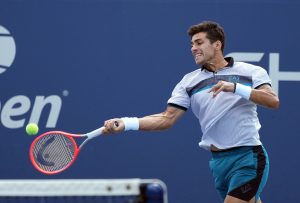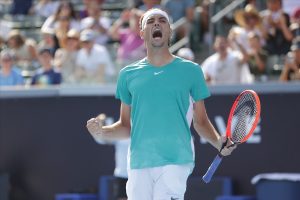Is Alexander Zverev becoming more like his big brother? Up until this point, the 21-year-old German tennis star has been known exclusively as an aggressive baseliner–a player content to rip groundstrokes from the back of the court and approach the net only when winning the point is a sure thing.
Two interesting questions for Alexander Zverev about being an aggressive baseliner:
- For a guy who’s 6’6″, isn’t it a waste of height and wingspan to only play from the back of the court? Imagine the volleys he could reach.
- Zverev’s older brother Mischa Zverev is a pure serve-and-volley style player. Mischa has made a career of approaching the net. Wouldn’t at least some of that rub off on his brother?
Now it has, apparently.
Alexander Zverev beat Dominic Thiem 6-4, 6-4 at the Madrid Open to claim his third career Masters 1000 title, and it did it with a subtle change in his game–approaching the net more, and doing it very successfully.
What happened in the Madrid Open Final marked a definite contrast in style. One player (Alexander Zverev) chose a more aggressive court position and playing style by willfully approaching more often. The other player (Dominic Thiem) almost never approached the net, stood way back behind the baseline and attempted to use power from the back of the court.
It also marks a change in how Alexander Zverev is playing tennis generally. Last year when he was bounced from the first round of the French Open, he stayed back and ultimately was out-grinded in a baseline battle. It was a waste of height, court, and athletic ability.
It appears the German star is working hard on his short game, and it’s paying off.
Let’s look at the numbers from yesterday’s match.
(First of all, a note on how this data was collected. Official tennis stats count all “net points” the same. An approach hit two feet behind the service line that results in a winner is considered a “net point won” even though the player was closer to the baseline than the net. An overhead hit at the net as a finishing shot–in which a player had no choice but to move forward to finish the point–is also considered a net point won. Those points do not necessarily account for a player actively deciding to move forward to finish the point. For this story, I watched the match and recorded every approach by both players. I looked at intent before and after the shot, as well as where the players were standing when the point ended. My numbers do not always agree with the official match stats because I have the luxury of going back and replaying the video again and again to determine what really happened. Official statisticians must make quick decisions in real time.)
Set #1
Zverev officially approached the net eight times and won four of those points. A closer look at what happened:
- Zverev willfully stepped into the court with the intention to finish at net six times. The other two times, he was drawn in.
- Zverev served-and-volleyed once, which resulted in Zverev winning the point by forcing an error after an excellent volley.
- Zverev made errors approaching or volleying three times.
- Zverev was passed at net by Thiem with an excellent passing shot for a winner only once.
- Thiem approached the net only one time- but not by choice. He was drawn in. Thiem won the point after Zverev missed a lob attempt.
Conclusion: It was messy and at times painful for Zverev, but he won the battle of the net, and most importantly, he won the set.
Sticking with this strategy, things got really good for Zverev after that.
Set #2
Zverev approached the net nine times, and won all nine of those points–and he did it with some flair and creativity.
- Zverev willfully stepped into the court with the intention to finish at net eight times. Once he was drawn in by Thiem.
- Zverev served-and-volleyed twice. In one instance, he did it on his second serve–cheeky. The other time he did it to set up double championship point–a memorable shot in which Zverev executed a perfect half volley angled for a winner.
- Zverev’s hands were much more steady on actual volleys than they were in the first set, a possible indication that sometimes he needs time in the match to find those shots rather than abandon the strategy.
As court positioning becomes more sophisticated in tennis, the days of simply ripping shots from the baseline might be coming to a close.
Players like Alexander Zverev making subtle adjustments to play from all positions on the court could emerge as a trend in the sport.
Main Photo:
Embed from Getty Images






